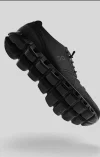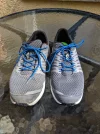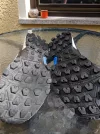The name "trail runners" conjures up in my mind running shoes for cross country and similar. So are they designed for long distance walking? I know people swear by them however my worry is that there might be unintended consequences in the long run (no pun intended). I know this will be heresy for some
Hi, happymarkos. A lot of folks probably wonder some of those same things

I hope this may be of help with how footwear for hiking and backpacking tend to be defined.
Road Running Shoes. These are generally the lightest of the basic category of sporting shoe. Road running shoes are designed to provide comfort, and motion control while keeping the shoe as light as possible because of competitive running sports. Running on pavement and sidewalks and hard surfaces are the primary focus. The comfort levels in these shoes provide enough cushioning to make them wearable over shorter time periods with each use as most competitive and recreational running is done for shorter periods of time every time they are put on. Cushioning and support slightly increase for shoe marketed for distance running sports, like marathons.
Trail Running Shoes. The differences between Street Running and Trail Running shoes are:
- traction and tread
- materials used and their durability
- levels of cushioning
- amount of motion control and support
- protection from off road and trail debris - getting poked in the sole by rocks and other sharp stuff which can make the bottoms of your feet sore or injured.
NOTE: A properly fitted shoe in this category should require no break in. These are not leather boots. The materials used do NOT 'break in' when worn, they break
down. If there are suspicious pressure points, or if they feel a bit tight, they will typically not get better until the materials start to break down. This category of shoe for backpacking or hiking should feel comfortable and fit well immediately out of the box.
Do not get me wrong, trail and road running shoes will slightly stretch and the footbeds will slightly mold and get incrementally even more comfortable. BUT, when new, they should already be comfortable and not damage or hurt your feet when taken on a 10 mile /16.4 km walk.
Trail Shoes. These are the beefy cousins to road and trail runners. They are:
- heavier due to design structures which include some use of leathers or thicker manmade materials in the uppers.
- their cushioning gives up more 'plush' to the cushioning in favor of more durability materials in the midsole.
- sometimes they will have a more aggressive tread design.
- stiffer in the forefoot.
Generally, their usable life is better than either a road or trail runner. Again, a proper fitting trail shoe does not generally require much, if any, 'breaking in' to feel good on the foot. Due to the heavier materials used in the uppers, they will become even more comfortable with wear as the heavier materials do more stretching, but like the other two types of shoes, they can be worn right out of the box without the need for extensive 'breaking in'.
Trail/hiking Boots. I am not going to talk about mountaineering boots, which are not meant for trails, hiking, or backpacking.
Trail/hiking/backpacking boots (any name works) are:
- less cushioned than the previous three types of footwear.
- significantly heavier, utilizing more energy to walk in.
- stiffer.
- they can generally be resoled.
- they can be insulated for cold weather walking (like my Lowa Camino GTX that I use in the winter), or not insulated.
- will outlast the other three categories of footwear by wide margins.
- takes the most time, and is the most challenging, to fit properly.
Depending on the boot's manufacturer and materials (fabric vs leather vs hybrid) it can take a considerable time to break-in a pair so that they feel really good on the feet and reduce potential issues like pinching and tightness and soreness to foot structures.
There are factors and characteristics for each category of footwear to consider; for example: when during the year will you be wearing them and what type of walking will you be doing. There are folks who prefer only going barefoot on one end of the spectrum, to those who wear the heaviest backpacking boot on the other end. Preferences in types and styles of footwear are subjective and personal. The reasons given to support one person's choice may or may not be valid for anyone else.
Over the years I have tested a lot of footwear from manufacturer's who specifically target backpacking, hiking, and mountaineering sports. I have tested shoes and boots which perform exceedingly well, but which I disliked wearing, and those which were wonderful to wear and I managed to be able to keep for my personal use.
For example, the Solomon Pro 3d series of shoes are great shoes, albeit a bit heavier than some other great shoes. A lot of people love them, including my oldest son (who now uses Hoka One One Speedgoats). When I tested them they performed extremely well ---- but I hated wearing them over the long run. That does not discount the fact that large numbers of users find them very comfortable to wear.
Patience plus trial and error. To find a great pair of shoes or boots that make your feet happy, requires an abundance of the former, and the willingness to be ruthless in your judgement for the latter.
 www.on-running.com
www.on-running.com
 www.saucony.com.au
www.saucony.com.au



























